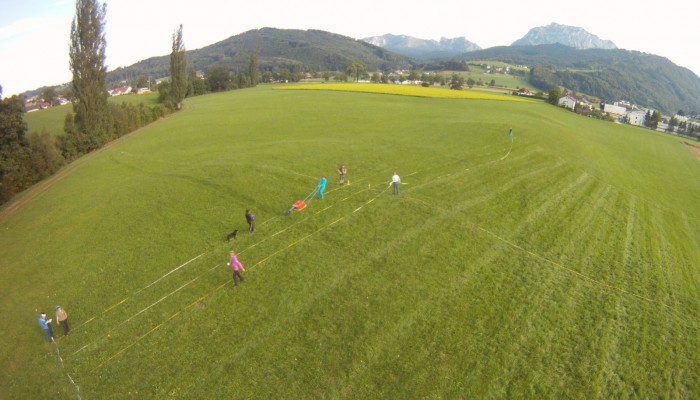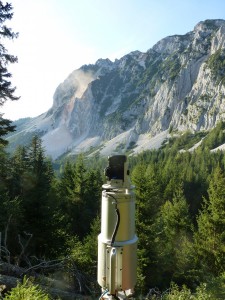
From Wednesday to Saturday 9-12 September 2015, the geography departments of the Universities of Bonn/Germany and Salzburg/Austria, held a joint field course in geomorphology in the eastern European Alps. During these four days, 24 students master students, half from each participating university, gathered in Gmunden, Austria. Here, in the beautiful Salzkammergut, the course addressed topics of geomorphology, geoarchaeology and natural hazards. During field trips and hands-on workshops, the students conceptualized and conducted traditional drilling techniques, geophysical surveys and terrestrial laserscanning to investigate surface and subsurface characteristics in several key sites.
In the Gschliefgraben, a complex and currently reactivating landslide at the northern foot of Mt. Traunstein, the depth of the failure plane and the subsurface moisture distribution was investigated using electrical resistivity tomography. Within a nearby Weichselian sandur plain the students sought to determine the extent of the so-called Roman Villa Engelhof using ground-penetrating radar.
 The shape and infill of a nearby located kettle hole mire (Krottensee) was investigated using electrical resistivity tomography. The figure below shows one of the resulting tomographies clearly indicating three layers with a floating mat on top in red, a body of water/gyttija underneath in blue, and the morainic kettle hole base in green colours.
The shape and infill of a nearby located kettle hole mire (Krottensee) was investigated using electrical resistivity tomography. The figure below shows one of the resulting tomographies clearly indicating three layers with a floating mat on top in red, a body of water/gyttija underneath in blue, and the morainic kettle hole base in green colours.
 Recent rockfall activity at the south face of Mt. Plassen (see picture to the left, nearby Hallstatt) and the north face of Mt. Traunstein was finally investigated and quantified by means of terrestrial laserscanning.
Recent rockfall activity at the south face of Mt. Plassen (see picture to the left, nearby Hallstatt) and the north face of Mt. Traunstein was finally investigated and quantified by means of terrestrial laserscanning.
The field course was hosted by five lecturers from the Universities of Bonn and Salzburg, Dr. Johannes Weidinger, Prof. Lothar Schrott, Dr. Joachim Götz, Dr. Thomas Hoffmann and Dr. Jan Blöthe. This was the first joint field course between two European Universities that we organized and even though the courses in both departments had a slightly different focus, bringing these ideas together in the field was easy. We have the feeling that students from both universities benefited from the discussions and the exchange of thoughts during field work. After this very positive experience, it probably won’t be the last joint MSc course we organized.
– Written by Jan Blöthe (University of Bonn, Germany) and Joachim Götz (University of Salzburg, Austria);
Featured image courtesy of Christoph Baumgartner
